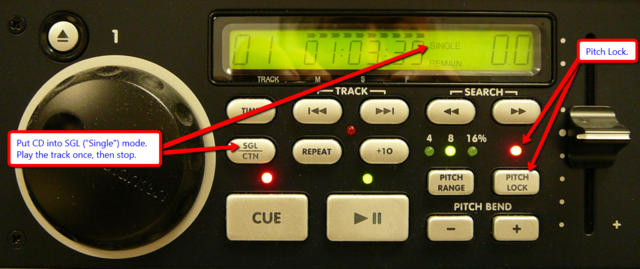Running the board: Difference between revisions
| Line 46: | Line 46: | ||
=== Basic Theory === | === Basic Theory === | ||
==== Pgm, Aud, Tel ==== | ==== Pgm, Aud, Tel ==== | ||
[[File:Pgm aud tel.png|thumb|300px|left|<div align="center">Channel out to PGM, Aud, & Tel.</div>]] | [[File:Pgm aud tel.png|thumb|300px|left|<div align="center">Channel 7 out to PGM, Aud, & Tel.</div>]] | ||
The board is a mixer. You may imagine sound playing into the different channels on the board; the decisions you make ''on'' the board decide which channels are on, how loudly they play, and where the sound goes next. | The board is a mixer. You may imagine sound playing into the different channels on the board; the decisions you make ''on'' the board decide which channels are on, how loudly they play, and where the sound goes next. | ||
Revision as of 14:39, 21 June 2011

Checklists
Setup
During the Show
- How to start the show
- How to play interludes:
- How to take a call
- Use slider to mute caller
- Use the "Off" button to hang up
- How to end the show
Shutdown
Tutorial
Basic Theory
Pgm, Aud, Tel
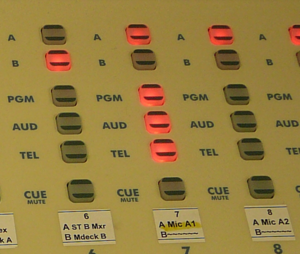
The board is a mixer. You may imagine sound playing into the different channels on the board; the decisions you make on the board decide which channels are on, how loudly they play, and where the sound goes next.
The "On" and "Off" buttons at the bottom of each channel decide whether that sound comes into the mixer.
The little buttons above the volume sliders decide where the sound on that line will go.
- PGM: output goes to the Program Computer to be broadcast live.
- Aud: output goes to Adobe Audition recorder.
- Tel: output goes to the telephone lines.
Going Live
The master computer directs all output from the board to the air, starting around 16:00:01, and takes the output from the board off the air around 16:56:31.
Either it works or it doesn't.
Getting the show on the air is not the lowly moderator's problem.
How to Set Up for the Show
Start Spark Chat
- Double-click the Spark icon.
- Select conference chat.
- Fuss with name to personalize it and get the desired color scheme. “Daughter of Zion†apparently is not a good color. “father†is hot pink.
Start Adobe Audition
- Double-click on icon.
- Click record button.
- A small window will pop up asking confirmation of the default bit rate. Click OK.
- May start this early. The material recorded before the program begins can be trimmed.
- Make sure that the recording track is not highlighted.
- Black = not highlighted; white = highlighted.
- If it is highlighted, it will stop recording at the end of the highlighted block.
- Sanity check: Start recording, minimize the window or drag another window over it, and make sure that the recording continues. Be careful not to highlight the track while doing the sanity check!
Start Flash Operator
- Double-click icon.
- Re-size and position windows as needed.
- Goal: get Spark and Operator arranged to your taste.
Plug Headphone into Board

- There is only one jack over in the lower righthand corner of the board.
- Turn Headphone on (Monitor is optional).
- Control volume with Headphone knob.
Studio A
Studio A: Microphone

Line 7: Microphone A1
- Highlight all 3 buttons at top (Pgm, Aud, Tel).
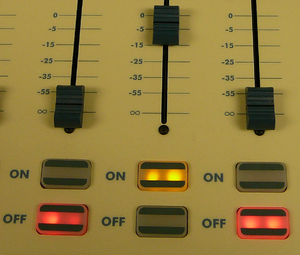
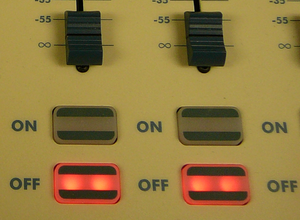
- Push “On†to use the mic, “Off†to clear throat.
Studio A: CD Player
Set Channels on the Board
CD1 & 2
- Line #14 = CD1 = Intro / Outro CD.
- Line #15 = CD2 = Interlude CD.
- Turn on three buttons above slider: Pgm, Aud, Tel.
- Turn line “On.â€
- Put Intro/Outro CD into CD player #1.
- Put Interlude CD into CD player #2.
- Bring sliders up to audible level.
- It only takes a minute to test that you have the right configuration. The Interlude plays for twenty seconds. Make sure that it plays only once and then stops. The next time you press play, it should play again once and stop.
Studio A: Configure CD player
- Put the player into "play one track and stop" mode.
- Put Pitch Lock on.
Studio A: Telephone Lines
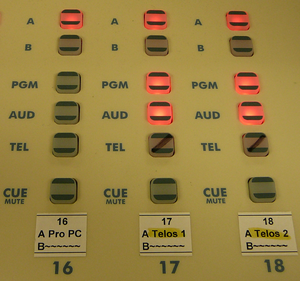

A1 and A2 are telephone lines. "A Telos 1" on the label means "Studio A, Telephone Line #1."
- Line 17 = A1
- Line 18 = A2
- Turn on Pgm and Aud but not Tel (!). Sending the telephone output back to the person on the telephone will create a wicked feedback loop. The Tel button has a black line drawn through it with magic marker to remind you of this essential step.
- Leave both lines off. This is like leaving a handset on a telephone. When the phone lines are "off," i.e., not in use, they are ready to receive a call. When the time comes, turning the line "on" will be exactly the same thing as picking up a telephone to answer it.
How to start the show
- Press play button on CD player at 16:00:01.
- Wait for the right chord, then fade music and do intro over it. Keep talking and the music
will quit after a minute.
How to play Interlude
Studio A: Interlude
- Interlude CD should be in player 2
- The three output buttons for player 2 (Pgm, Aud, Tel) should be on.
- The input line for player 2 should be on
- Press play button for CD player 2
Studio B: Interlude
How to take a call
- Make sure that the line you want to use (A1 or A2) is "Off." You can't answer a telephone call when the receiver is off the telephone; you can't answer a transferred call unless the line is "Off" when the call is transferred.
- Drag tiny people icon from lines 51-54 to the tiny telephone icon on the A1 or A2 connection with the mouse. It is really important that you drop the tiny people icon on the tiny telephone icon. If you fail this test of hand-eye coordination, the call is dropped! I have asked and prayed for a better system, but we cannot afford it at present.
- Release the mouse button with your right hand and depress "On" button with your left hand. There is no rush. The caller will hear the phone ringing as the transfer is made. You have at least a minute to "answer the call" by pressing the "On" button.
- Bring up caller's slider while saying "Hello, _____, you are on the air ...", and then adjust the slider volume as needed when they start speaking.
- Remember the name of the person transferred to A1 or A2. There is no cue available after the call is transferred.
Use slider to mute caller
- To keep the caller on the line but to silence them, bring the slider down to zero.
Use the "Off" button to hang up
- The "Off" button drops the line.
- Reset level on slider to average.
How to end the show
- Lower slider on Line #4 – CD 1.
- Start outro music playing on CD player at 16:55:31.
- Bring up music gradually to audible-but-notoverpowering level.
- Do outro. Stop talking before 16:56:31.
- Bring music slider up to normal level and let the music finish. Goal: hit last chord before the Program computer switches to next output.
Save the recording
- Stop the recording in Adobe Audition.
- In Adobe, File / Save As
- Browse to My Computer → (Z:) → Production → CAC → {this month-this year}
- Left-click once if there is a file in the folder already, then edit the date. Otherwise, name file like this: CAC-MMDDYY.mp3.
- So, for example, the November 8, 2010, show ends up with this filename:
- Z:\Production\CAC\November-2010\CAC-110810.wav
- Click Save.
Shut down
- Turn off all lines and all buttons on the board.
- Turn off the CD player on Friday afternoon.
- Exit Spark, Flash Operator, and Adobe
Audition.
- Turn off the computer monitor.
- Studio A: Open the door to the computer room to improve circulation. Close the door to the corridor after exiting the studio.
- Say goodnight, Gracie.
